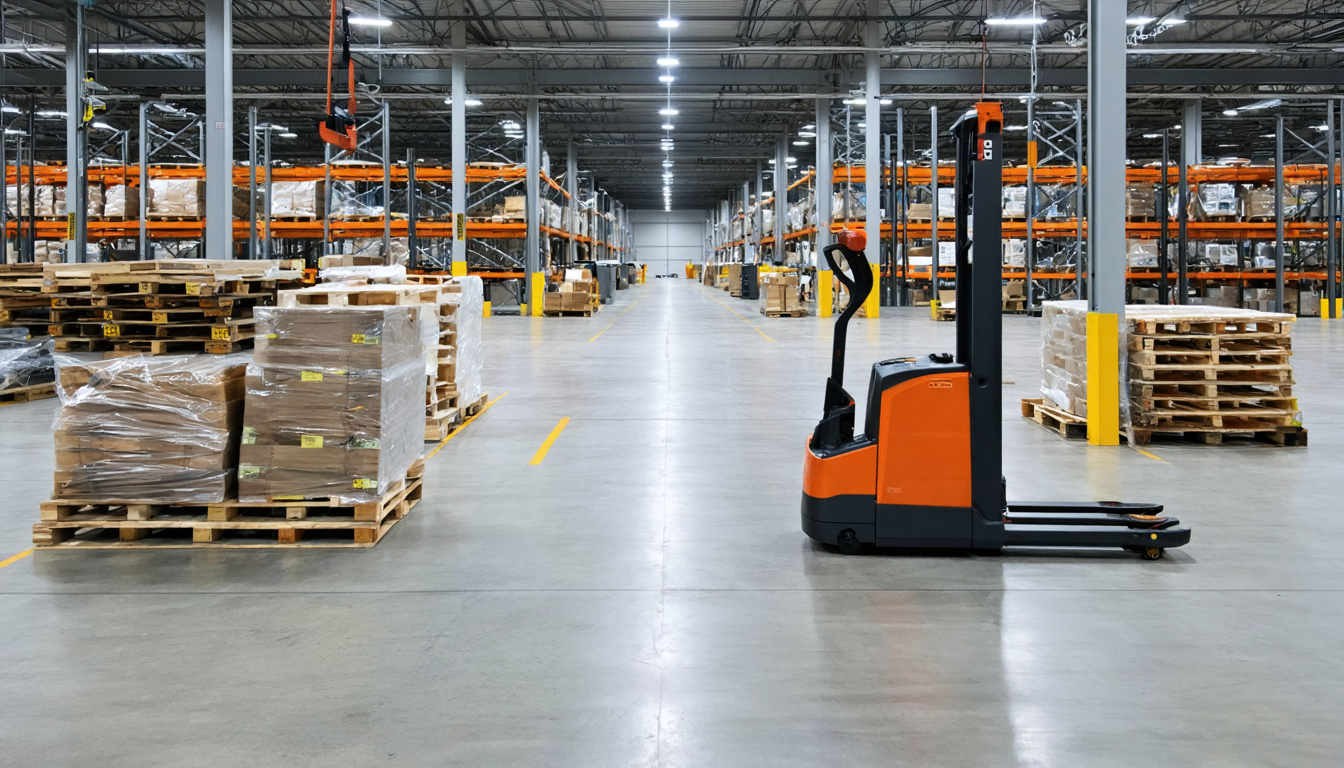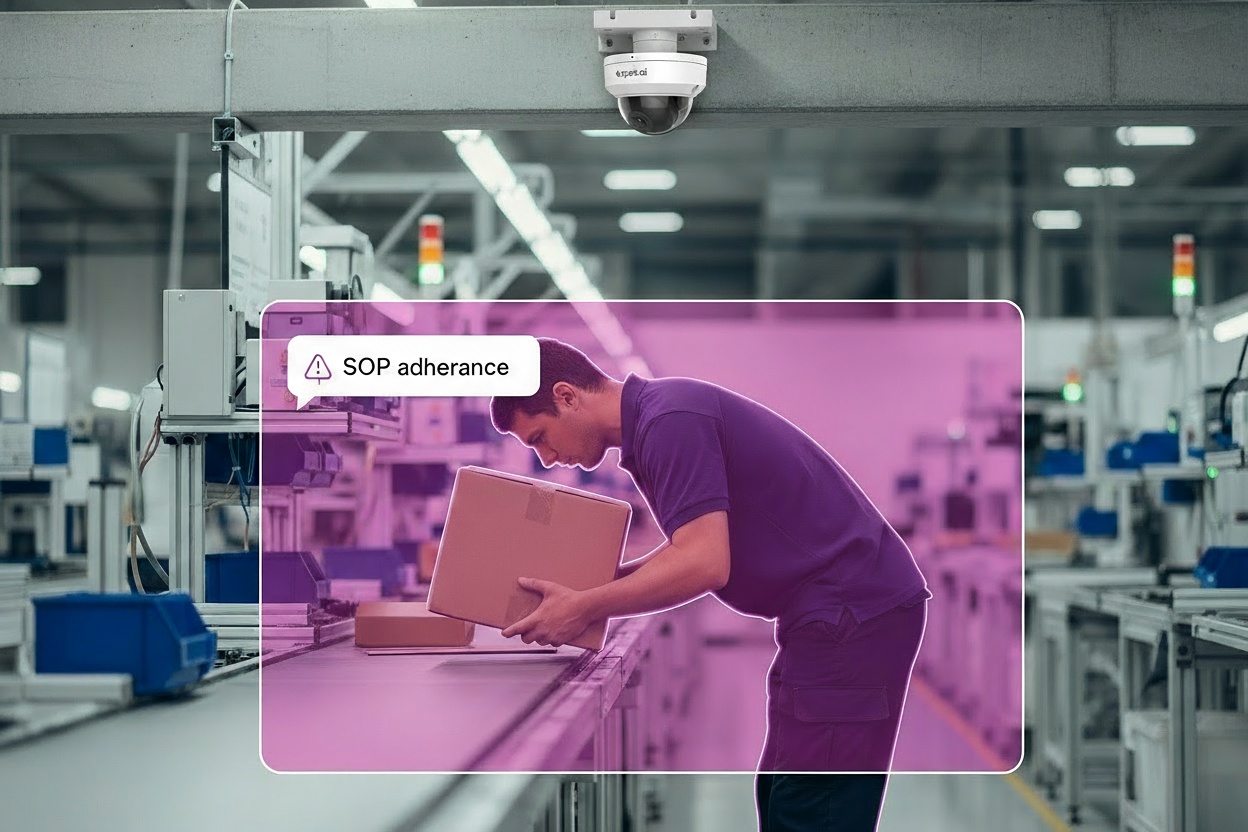Every year, musculoskeletal disorders (MSDs)—think strains, sprains, and overexertion injuries—affect hundreds of thousands of manufacturing workers in the U.S. alone. These injuries cost manufacturers billions in lost productivity, workers’ compensation, and medical bills, making them a major operational hurdle. Yet, the vast majority of these injuries can be mitigated with a smarter, more forward-looking approach to safety.
Today, manufacturing safety leaders have a new edge: video AI. When combined with proven protocols and ergonomic best practices, this technology helps teams spot, understand, and address MSD risks—addressing them before they escalate into recordable incidents. This guide breaks down the true costs, root causes, and offers a clear framework for moving from a reactive to an anticipatory safety model using current technology.
Why musculoskeletal disorders are a major cost center for manufacturing
MSDs—think strains, sprains, back injuries, and repetitive motion disorders—aren’t dramatic, but their impact is substantial. These incidents are a major driver of non-fatal injuries in the manufacturing sector. The direct costs from workers’ compensation claims are considerable, but the real drain comes from the ripple effects—lost productivity, overtime, retraining, and employee turnover—pushing the total economic toll even higher.
Behind every number is a story: a maintenance worker strains his back freeing a stuck steel reel; a machinist develops carpal tunnel after years at a poorly set-up workstation; a new hire pulls a muscle lifting awkward materials. The common thread? Overexertion, repetition, and addressable ergonomic hazards.
The top 5 causes of musculoskeletal disorders in manufacturing—and how to address them
The best way to mitigate MSDs is to understand why they happen. Here are the top five root causes of MSDs in manufacturing—and how a blend of established protocols and video AI can help you keep your people healthy and your lines moving.
1. Manual Material Handling: Lifting, Pushing, and Pulling

The Hazard:
A line worker is tasked with moving 280-pound steel wire reels from a payoff machine. When the reel sticks, he strains to free it—resulting in a back injury. This is a common scenario, as overexertion during lifting contributes to a large number of MSD injuries in manufacturing.
Traditional Mitigation:
Invest in hoists, pallet jacks, and lift tables.
Provide hands-on training in safe lifting techniques.
Enforce job rotation to limit repetitive strain.
How AI Amplifies Mitigation:
Video AI can help teams monitor for unsafe behaviors in high-risk zones. For example, alerts for "Person Enters No-go Zone" can flag when workers are in areas where heavy lifting should only be done with mechanical aids. This allows supervisors to review events and identify patterns of unsafe lifting or bypassing of assist tools, driving targeted training and ergonomic adjustments.
2. Repetitive Motions and Assembly-Line Work
The Hazard:
An assembly operator spends hours installing fasteners in awkward positions, day after day. Months later, she develops neck pain, requiring an extensive therapy. Repetitive motions are a leading cause of chronic MSDs in manufacturing.
Traditional Mitigation:
Rotate workers between different tasks and stations.
Schedule micro-breaks and encourage stretching.
Ergonomic assessments of workstations.
How AI Amplifies Mitigation:
While AI doesn't directly measure repetitive motion, video analysis allows safety teams to easily review footage of specific workstations to conduct ergonomic assessments. Using features like "Time Studies," leaders can analyze how long workers spend on certain tasks, helping to optimize job rotation schedules and adjust workflows to reduce strain.
3. Awkward Postures and Poor Ergonomics
The Hazard:
A technician repairs equipment overhead, twisting and reaching for long stretches. Over time, this causes lumbar and shoulder strain, ultimately leading to lost workdays. Awkward postures are a major risk factor for MSDs, especially when workstations aren’t designed with the worker in mind.
Traditional Mitigation:
Redesign workstations with adjustable heights and better tool placement.
Use anti-fatigue mats and ergonomic supports.
Conduct regular ergonomic risk assessments.
How AI Amplifies Mitigation:
Video AI can use proxies like "Running" to flag potential ergonomic hazards. These alerts draw attention to moments of distress or unsafe behavior, helping teams identify workstations or tasks that may be causing workers to bend, stretch, or work in awkward positions, allowing for targeted, data-driven interventions.
4. Production Pressure and Unsafe Behaviors
The Hazard:
Under tight deadlines, workers rush, skip proper lifting steps, or ignore fatigue. One worker ignores back pain to meet quota, leading to a hernia that keeps him off the job for weeks. Production pressure often leads to shortcuts—and injuries.
Traditional Mitigation:
Foster a culture of safety over speed.
Encourage early reporting of discomfort.
Supervisory observation and coaching.
How AI Amplifies Mitigation:
Video AI can spot unsafe behaviors like running, hurrying, or skipping safety steps. These “running” proxies allow for on-the-spot coaching and help leaders identify when production demands are creating unsafe conditions, so they can intervene to reduce risk.
5. Poor PPE Compliance and Lack of Training
The Hazard:
A worker skips wearing anti-fatigue insoles or ignores a required exoskeleton when moving heavy equipment. Weeks later, cumulative strain leads to a back injury. Poor PPE compliance and insufficient training are common roots of addressable MSDs.
Traditional Mitigation:
Enforce PPE policies through spot checks.
Provide regular ergonomic training and workshops.
Post signage and reminders at workstations.
How AI Amplifies Mitigation:
Video AI can automatically detect missing wearable PPE, such as hard hats or safety vests, and alert supervisors. While it doesn't detect environmental equipment like anti-fatigue mats, the system allows for easy visual verification to ensure all safety protocols are followed—helping manufacturing teams stay OSHA-compliant and reduce injuries.
Integrating a video AI camera system: from NVR to operational insights in manufacturing
Upgrading your safety tech doesn’t mean ripping out what you have. Video AI platforms are designed to work with your existing infrastructure—including common Power over Ethernet (POE) cameras. No full “rip-and-replace” required.
Here’s how a cloud-native, AI-enabled video system enhances safety:
Feature | Traditional NVR | AI-Powered Video Platform |
|---|---|---|
Camera Compatibility | Requires new or specific cameras | Works with existing POE cams |
Storage | On-prem hardware | Secure, cloud-native, scalable |
Maintenance | Frequent, on-site | Minimal, remote updates |
User Access | Limited seats | Unlimited users, unified dashboard |
Video Review | Manual, slow | AI-driven search and incident detection |
Actionable Insights | Passive footage | Live alerts running, and crowding |
With an AI analysis layer on top of your video feeds, every camera becomes an intelligent teammate for your safety program. You can surface critical events—missing PPE, or running in restricted zones—with live visibility, significantly reducing incident investigation time and allowing for data-driven adjustments.
Integration is straightforward:
Connect plug-and-play hardware to your existing camera network.
Bridge on-premise feeds to a secure cloud dashboard.
AI tools help you surface, investigate, and resolve safety issues—without hunting through hours of footage.
Tips for manufacturing safety leaders:
Prioritize solutions that support ergonomic and PPE compliance goals.
Ensure compatibility with your current camera infrastructure.
Choose platforms that offer unlimited user access—so safety isn’t siloed.
Integrate with existing incident reporting and safety training programs.
Ready to move from reactive investigations to insight-driven risk mitigation? Video AI makes it possible—without the rip-and-replace pain.
Improve manufacturing safety—book a safety consultation
Every MSD is a call to action. By combining reliable safety protocols with video AI, manufacturing leaders can reduce risk, speed up investigations, and deliver a safer, more productive floor.
Curious how video AI can help your safety team reduce injuries and streamline investigations? See Spot AI in action and explore how our platform supports anticipatory risk mitigation.
Frequently asked questions
What are the main causes of musculoskeletal disorders in manufacturing?
The leading causes are overexertion from manual material handling (lifting, pushing, pulling), repetitive motions in assembly-line work, awkward postures, production pressure leading to unsafe behaviors, and poor PPE compliance.
How can manufacturing sites implement safety technology without disrupting production?
Video AI platforms connect directly to your existing cameras, overlaying analytics without interrupting daily operations. They automate hazard detection and reporting, supporting your staff rather than replacing them.
Are there compliance standards for MSD mitigation in manufacturing?
Yes. OSHA’s General Duty Clause requires employers to provide a workplace free from recognized hazards—including ergonomic risks associated with MSDs (Source: OSHA). Some states, like Minnesota, now require ergonomic risk assessments and training for high-risk industries.
What practical steps should manufacturing teams take before adopting video AI technology?
Start with a risk assessment—identify high-traffic and high-lift areas and current camera coverage. Involve IT, safety, and operations teams early. Pilot the system in a problem area, review results, then expand based on the data.
How can safety technology help reduce stress for safety professionals?
AI-driven analytics automate hazard detection, freeing safety professionals from endless manual monitoring and reporting. This lets them focus on anticipatory planning and team support, rather than reacting to every incident.
How does reducing MSDs with AI also decrease manufacturing downtime?
Every injury causes unscheduled downtime for incident investigation, cleanup, and finding a replacement worker. Video AI helps minimize these stoppages by flagging unsafe behaviors—like entering a no-go zone or running—in real time. This allows supervisors to intervene before an injury occurs, protecting both your team and your production schedule.
About the author
Joshua Foster is an IT Systems Engineer at Spot AI, where he focuses on designing and securing scalable enterprise networks, managing cloud-integrated infrastructure, and automating system workflows to enhance operational efficiency. He is passionate about cross-functional collaboration and takes pride in delivering robust technical solutions that empower both the Spot AI team and its customers.

























.png)
.png)
.png)